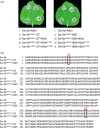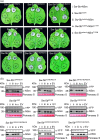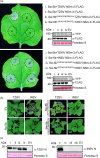Stepwise artificial evolution of an Sw-5b immune receptor extends its resistance spectrum against resistance-breaking isolates of Tomato spotted wilt virus
- PMID: 34036713
- PMCID: PMC8541788
- DOI: 10.1111/pbi.13641
Stepwise artificial evolution of an Sw-5b immune receptor extends its resistance spectrum against resistance-breaking isolates of Tomato spotted wilt virus
Abstract
Plants use intracellular nucleotide-binding leucine-rich repeat immune receptors (NLRs) to recognize pathogen-encoded effectors and initiate immune responses. Tomato spotted wilt virus (TSWV), which has been found to infect >1000 plant species, is among the most destructive plant viruses worldwide. The Sw-5b is the most effective and widely used resistance gene in tomato breeding to control TSWV. However, broad application of tomato cultivars carrying Sw-5b has resulted in an emergence of resistance-breaking (RB) TSWV. Therefore, new effective genes are urgently needed to prevent further RB TSWV outbreaks. In this study, we conducted artificial evolution to select Sw-5b mutants that could extend the resistance spectrum against TSWV RB isolates. Unlike regular NLRs, Sw-5b detects viral elicitor NSm using both the N-terminal Solanaceae-specific domain (SD) and the C-terminal LRR domain in a two-step recognition process. Our attempts to select gain-of-function mutants by random mutagenesis involving either the SD or the LRR of Sw-5b failed; therefore, we adopted a stepwise strategy, first introducing a NSmRB -responsive mutation at the R927 residue in the LRR, followed by random mutagenesis involving the Sw-5b SD domain. Using this strategy, we obtained Sw-5bL33P/K319E/R927A and Sw-5bL33P/K319E/R927Q mutants, which are effective against TSWV RB carrying the NSmC118Y or NSmT120N mutation, and against other American-type tospoviruses. Thus, we were able to extend the resistance spectrum of Sw-5b; the selected Sw-5b mutants will provide new gene resources to control RB TSWV.
Keywords: Tomato spotted wilt virus; NLR; Sw-5b; artificial evolution; immune receptor; resistance breaking.
© 2021 The Authors. Plant Biotechnology Journal published by Society for Experimental Biology and The Association of Applied Biologists and John Wiley & Sons Ltd.
Conflict of interest statement
The authors declare that they have no competing interest.
Figures






Similar articles
-
Determination of key residues in tospoviral NSm required for Sw-5b recognition, their potential ability to overcome resistance, and the effective resistance provided by improved Sw-5b mutants.Mol Plant Pathol. 2022 May;23(5):622-633. doi: 10.1111/mpp.13182. Epub 2021 Dec 27. Mol Plant Pathol. 2022. PMID: 34962031 Free PMC article.
-
Natural Resources Resistance to Tomato Spotted Wilt Virus (TSWV) in Tomato (Solanum lycopersicum).Int J Mol Sci. 2021 Oct 12;22(20):10978. doi: 10.3390/ijms222010978. Int J Mol Sci. 2021. PMID: 34681638 Free PMC article. Review.
-
The NSm proteins of phylogenetically related tospoviruses trigger Sw-5b-mediated resistance dissociated of their cell-to-cell movement function.Virus Res. 2017 Aug 15;240:25-34. doi: 10.1016/j.virusres.2017.07.019. Epub 2017 Jul 25. Virus Res. 2017. PMID: 28754561
-
Cell death triggering and effector recognition by Sw-5 SD-CNL proteins from resistant and susceptible tomato isolines to Tomato spotted wilt virus.Mol Plant Pathol. 2016 Dec;17(9):1442-1454. doi: 10.1111/mpp.12439. Epub 2016 Aug 14. Mol Plant Pathol. 2016. PMID: 27271212 Free PMC article.
-
Three decades of managing Tomato spotted wilt virus in peanut in southeastern United States.Virus Res. 2017 Sep 15;241:203-212. doi: 10.1016/j.virusres.2017.05.016. Epub 2017 May 24. Virus Res. 2017. PMID: 28549856 Review.
Cited by
-
Engineering plant immune circuit: walking to the bright future with a novel toolbox.Plant Biotechnol J. 2023 Jan;21(1):17-45. doi: 10.1111/pbi.13916. Epub 2022 Sep 27. Plant Biotechnol J. 2023. PMID: 36036862 Free PMC article. Review.
-
Determination of key residues in tospoviral NSm required for Sw-5b recognition, their potential ability to overcome resistance, and the effective resistance provided by improved Sw-5b mutants.Mol Plant Pathol. 2022 May;23(5):622-633. doi: 10.1111/mpp.13182. Epub 2021 Dec 27. Mol Plant Pathol. 2022. PMID: 34962031 Free PMC article.
-
Association of the tomato co-chaperone gene Sldnaj harboring a promoter deletion with susceptibility to Tomato spotted wilt virus (TSWV).Hortic Res. 2025 Jan 15;12(4):uhaf019. doi: 10.1093/hr/uhaf019. eCollection 2025 Apr. Hortic Res. 2025. PMID: 40093380 Free PMC article.
-
NLR receptors in plant immunity: making sense of the alphabet soup.EMBO Rep. 2023 Oct 9;24(10):e57495. doi: 10.15252/embr.202357495. Epub 2023 Aug 21. EMBO Rep. 2023. PMID: 37602936 Free PMC article. Review.
-
Natural Resources Resistance to Tomato Spotted Wilt Virus (TSWV) in Tomato (Solanum lycopersicum).Int J Mol Sci. 2021 Oct 12;22(20):10978. doi: 10.3390/ijms222010978. Int J Mol Sci. 2021. PMID: 34681638 Free PMC article. Review.
References
-
- Aramburu, J. and Marti, M. (2003) The occurrence in north‐east Spain of a variant of Tomato spotted wilt virus (TSWV) that breaks resistance in tomato (Lycopersicon esculentum) containing the Sw‐5 gene. Plant Pathol. 52, 407.
-
- Aravind, L. (2000) The BED finger, a novel DNA‐binding domain in chromatin‐boundary‐element‐binding proteins and transposases. Trends Biochem. Sci. 25, 421–423. - PubMed
-
- Batuman, O. , Turini, T.A. , Oliveira, P.V. , Rojas, M.R. , Macedo, M. , Mellinger, H.C. , Adkins, S. et al. (2017) First report of a resistance‐breaking strain of tomato spotted wilt virus infecting tomatoes with the Sw‐5 tospovirus‐resistance gene in California. Plant Dis. 101, 637.
-
- Bendahmane, A. , Farnham, G. , Moffett, P. and Baulcombe, D.C. (2002) Constitutive gain‐of‐function mutants in a nucleotide binding site‐leucine rich repeat protein encoded at the Rx locus of potato. Plant J. 32, 195–204. - PubMed
-
- van der Biezen, E.A. and Jones, J.D. (1998) The NB‐ARC domain: a novel signalling motif shared by plant resistance gene products and regulators of cell death in animals. Curr. Biol. 8, R226–227. - PubMed
Publication types
MeSH terms
LinkOut - more resources
Full Text Sources
Other Literature Sources

